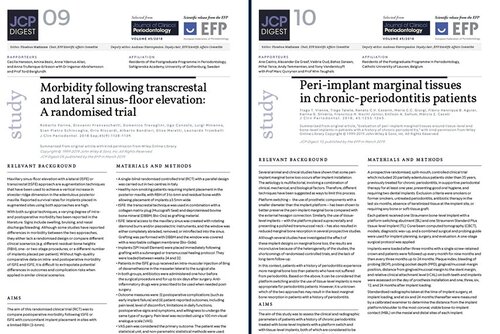![]()
25 March 2019
Latest issues of JCP Digest focus on key topics in implant surgery
Categories:Clinical Practice, Communication, Science

The latest two issues of the EFP research summary JCP Digest have been published, casting light on two key topics in implant dentistry: maxillary sinus-floor elevation and bone- and tissue-level implants in patients with chronic periodontitis.
JCP Digest 09 (2018: 45) provides a summary of research carried out at universities of Ferrara and Modena in Italy to compare postoperative morbidity following different augmentation techniques and subsequent implant placement.
It describes a randomised clinical trial that compared maxillary sinus-floor elevation using the lateral (lSFE) and transcrestal (tSFE) augmentation techniques to achieve a vertical increase in alveolar-ridge dimension in the edentulous posterior maxilla.
The aim was to compare postoperative morbidity following lSFE or tSFE with concomitant implant placement in sites with a limited residual-bone height (3-6mm).
Researchers found that lSFE was associated with lower pain on the day of surgery, while tSFE showed lower postoperative morbidity and a more tolerable postoperative course.
They said that tSFE may be an alternative to lSFE where there is limited residual-bone height, noting that “even though pain was higher on the day of surgery, the postoperative course seems to be more rapid and eventless.” They added that comparative data on the long-term outcomes of both treatment approaches are needed to be able to evaluate if one is superior to the other.
The study, published in full in the September 2018 edition of the Journal of Clinical Periodontology (JCP), was summarised for JCP Digest by students of the postgraduate programme in periodontology at the Sahlgrenska Academy at the University of Gothenburg in Sweden.
Tissue-level versus bone-level implants
JCP Digest 10 (2018: 45) summaries research that assessed the clinical and radiographic parameters of patients with a history of chronic periodontitis who had been treated with either bone-level implants with a platform switch or tissue-level implants. Both approaches are considered to protect against peri-implant marginal bone loss.
This prospective, randomised, split-mouth controlled trial – which included 20 partially edentulous patients older than 35 – found that both types of implant performed equally well in clinical and radiographic terms.
The Brazilian researchers concluded that it was not clinically relevant whether patients with a history of chronic periodontitis were rehabilitated with bone-level implants with a platform switch or with tissue-level implants – at least over a period of two years.
This research, published in the October 2018 edition of the JCP, was summarised for JCP Digest by students of the postgraduate programme in periodontology at the Catholic University of Leuven in Belgium.




